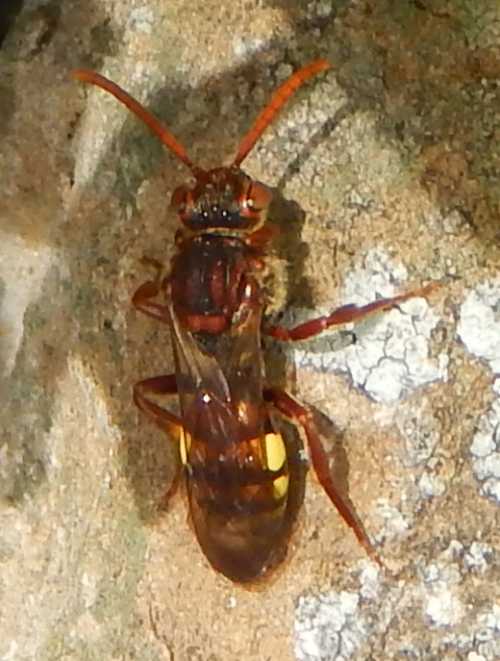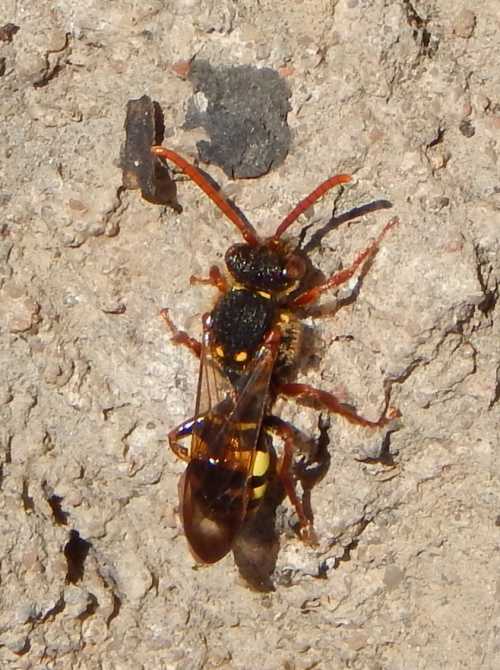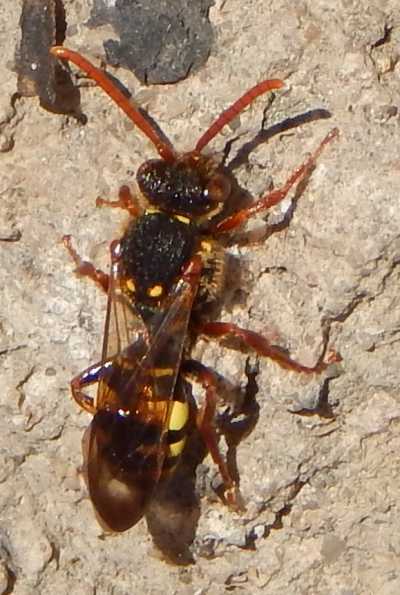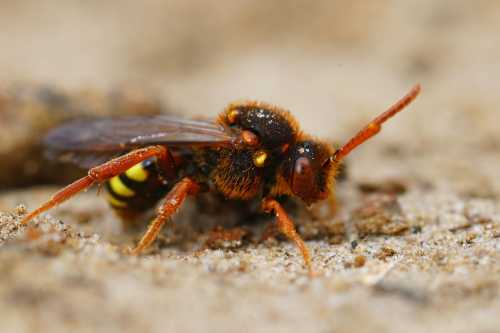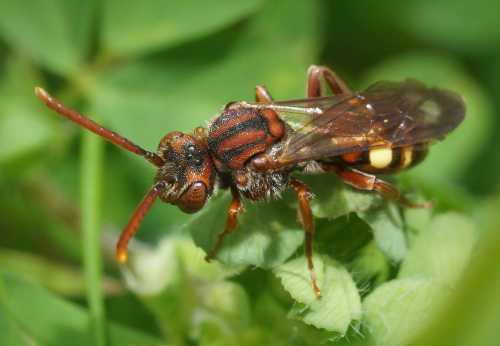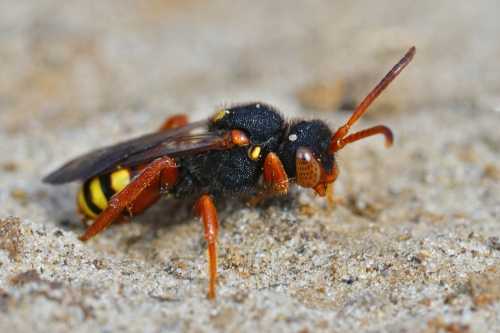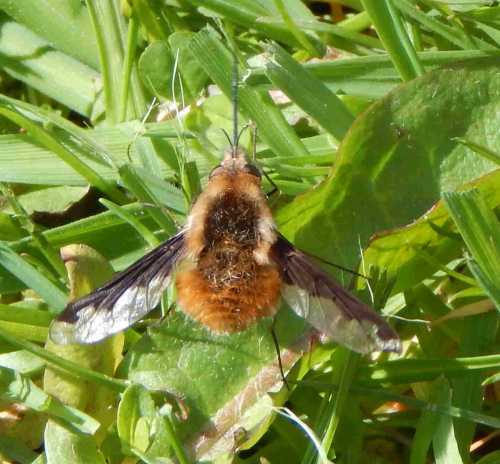About The Nomad Bee
Updated: 28th February 2021
Nomad bees (Nomada sp.) can easily be mistaken for small wasps. Most feature yellow and black wasp-like markings, or have brick-red/brown-red and black bodies and heads.
An Introduction To Nomada - Nomad Bees
Cleptoparasites are organisms that target the provisions gathered by the host for her own young. The female enters the host nest and deposits an egg, but never occupies the nest herself1.
The cleptoparasite's offspring then feed off the food supplies intended for that of the host.
Nomada are cleptoparasites that especially target the nests of Andrena (mining) species and also Melitta (blunthorn bees). It is believed that some species target very specific hosts, whilst others have several.
Nesting behaviour
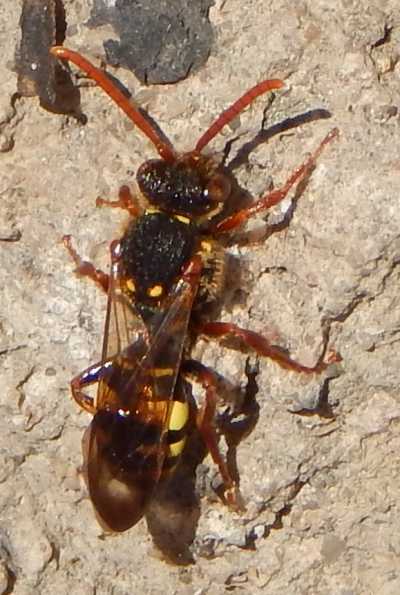 Marsham's Nomad Bee - Nomada marshamella female
Marsham's Nomad Bee - Nomada marshamella female
The females use olfactory and visual cues for detecting suitable host nests2. Upon locating a suitable host nest, she lands nearby, and rests facing the nest entrance.
At some point, she enters the host nest where she lays an egg in the wall of a single cell, then leaves.
The host bee will continue to provision the nest cell with food and then seal up the cell. The larvae that hatch from the egg of Nomada have large mandibles (jaws), which they use to destroy the grub of the host bee, and eat the food supplied by its parent.
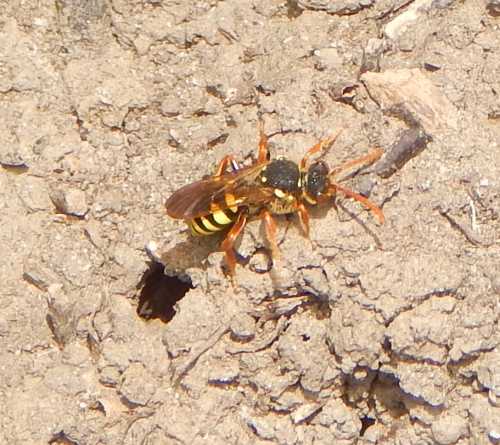 Gooden's nomad bee just leaving the host nest.
Gooden's nomad bee just leaving the host nest.As a cleptoparastie (a brood parasite), Nomada species have no pollen baskets or scopa on the hind legs for collecting pollen, nor can they create their own nest cells. They are therefore completely reliant on a host.
However, it should be noted that they are different from social parasite species, such as the cuckoos of bumble bees, which not only enter the nest of a host, but seek to dominate it, with the egg-laying female ousting the incumbent queen, and remaining in the nest to rear her young, using the provisions of the original queen and her workers.
I know from experience that some readers may take an instant and understandable disliking to this species, it being a cleptoparasite, but at the very least I am cheered to hope that its very existence depends upon a healthy population of the host species.
Why are nomad bees and their offspring not detected or attacked by their host?
It could be asked how Nomada species are able to parasitize the nest of the host. It appears that both the visit by the parasite and the egg it leaved behind, apparently remain undetected.
This topic has been studied by scientists, and it is proposed that at least some Nomada species may mask the odours that would betray their visit, by using chemical compounds that they produce themselves, and which mimic those produced by their host1,3, typically bees from the Andrena or Melitta generas. In both genera, nest cells are lined with secretions produced by the Dufour's gland of the nesting female. It is compounds within these chemicals that the visiting Nomada species are believed to mimic3. Furthermore, the chemical may be passed from the male Nomad bee to the female during mating3,4 via glands on the antennae4.
The offspring of Nomada hatch a little earlier than those of the host, enabling the parasite to destroy the grub of the host and eat the food provisions for itself.
Keeping a look out for nomad bees
Firstly, nomad bees have a slow, almost gliding flight, with legs splayed outward to the sides.
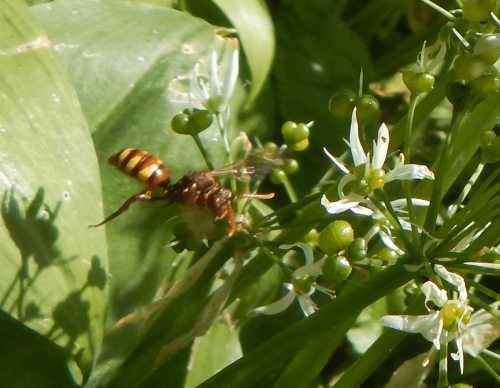 Panzer's NomadBee - Nomada panzerei female in flight.
Panzer's NomadBee - Nomada panzerei female in flight.
They are quite easy to spot, lurking around the nests of host species, which are often tunnels in dry mud, sandy or grassy banks, or around crevices in logs, tree stumps, walls and rocks - i.e. the locations of solitary bee nests. Hence, whilst prowling nest sites, they will be seen flying low.
They might also be found foraging on patches of flowers nearby.
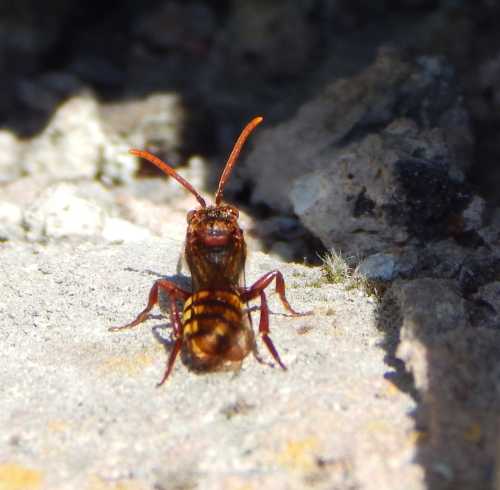 Flavous Nomad Bee - Nomada flava - female, lurks outside the nest of a potential target host.
Flavous Nomad Bee - Nomada flava - female, lurks outside the nest of a potential target host.Once the females have located a potential host, they will land and face the entrance. This provides an opportunity to have a good look at the particular species of nomad bee, although they are easily disturbed and may fly off.
Nomada worldwide
The Nomada, genus is one of the largest in the entire Apidae bee family, and the largest genus of cleptoparasitic "cuckoo
bees."
Some authors assert the number of species is more than 700 species worldwide (Wilson & Messinger Carril), whilst others state that there are about 850 described species (Falk - Field Guide to Bees Of Great Britain And Ireland).
From both sets of authors we can glean that:
- Nearly 300 can be found in the US, fewer than 40 in Canada (Wilson & Messinger Carril - The Bees In Your Backyard)
- There were 34 known Nomada species in the British Isles detailed in Falk's field guide in 2015.
However, in 2019, Falk published a paper in the British Journal of Entomology & Natural History5, along with fellow entomologist, Rosie Earwalker, describing a recent arrival to Britain: the Dusky-horned Nomad Bee, Nomada bifasciata. The paper also mentions another newcomer to the British Isles, Nomada alboguttata, the Large Bear-clawed Nomad Bee.
Not to be confused with wasps!
A number of wasps - especially solitary wasps such as the field digger wasp below, are similar in appearance to nomad bee species. Indeed, bees are related to wasps.
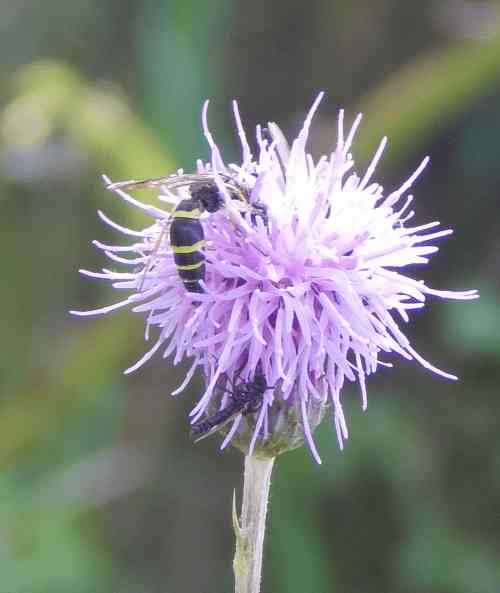 Field digger wasp foraging on knapweed.
Field digger wasp foraging on knapweed.Explore nomad bee species
References
1. Litman JR. Under the radar: detection avoidance in brood parasitic bees. Philos Trans R Soc Lond B Biol Sci. 2019;374(1769):20180196. doi:10.1098/rstb.2018.0196
2. Cane JH. 1983. Olfactory evaluation of Andrena host nest suitability by kleptoparasitic Nomada bees (Hymenoptera, Apoidea). Anim. Behav. 31, 138–144. (10.1016/S0003-3472(83)80181-X) [CrossRef] [Google Scholar] [Ref list]
3. Tengö J, Bergström G (1977). Cleptoparasitism and odor mimetism in bees: Do Nomada males imitate the odor of Andrena females? Science 196: 1117–1119. https://doi.org/10.1126/science.196.4294.1117
4. Schindler M, Hofmann MM, Wittmann D, Renner SS (2018). Courtship behaviour in the genus Nomada – antennal grabbing and possible transfer of male secretions. Journal of Hymenoptera Research 65: 47-59. https://doi.org/10.3897/jhr.65.24947
5. Falk, S, Earwaker, R (2019). Dusky-horned Nomad Bee, Nomada bifasciata, new to Britain (Hymenoptera: Apidae). British Journal of Entomology & Natural History 32(2):170-175.
